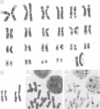Abstract
A family is described in which the proband has a rearranged X chromosome involving monosomy Xp and trisomy Xq, while the mother has a paracentric inversion of chromosome 7. It is suggested that the phenomenon of interchromosomal effect may link these observations. A brief review of the published and computer catalogued data on paracentric inversion in man is included.
Full text
PDF



Images in this article
Selected References
These references are in PubMed. This may not be the complete list of references from this article.
- Aurias A., Prieur M., Dutrillaux B., Lejeune J. Systematic analysis of 95 reciprocal translocations of autosomes. Hum Genet. 1978 Dec 29;45(3):259–282. doi: 10.1007/BF00278725. [DOI] [PubMed] [Google Scholar]
- Canki N., Dutrillaux B. Two cases of familial paracentric inversion in man associated with sex chromosome anomaly. 47,XXY,inv(5)(q21q32) and 45,X,inv(7)(q11.3q22.3). Hum Genet. 1979 Apr 5;47(3):261–268. doi: 10.1007/BF00321018. [DOI] [PubMed] [Google Scholar]
- Del Porto G., D'Alessandro E., De Matteis C., D'Innocenzo R., Baldi M., Pachi A., Cappa F. Familial paracentric inversion of chromosome 15 (q15q24). J Med Genet. 1984 Dec;21(6):451–453. doi: 10.1136/jmg.21.6.451. [DOI] [PMC free article] [PubMed] [Google Scholar]
- Fryns J. P., Van den Berghe H. Paracentric Inversion in man: personal experience and review of the literature. Hum Genet. 1980;54(3):413–416. doi: 10.1007/BF00291590. [DOI] [PubMed] [Google Scholar]
- Hoo J. J., Lorenz R., Fischer A., Fuhrmann W. Tiny interstitial duplication of proximal 7q in association with a maternal paracentric inversion. Hum Genet. 1982;62(2):113–116. doi: 10.1007/BF00282296. [DOI] [PubMed] [Google Scholar]
- LEJEUNE J. AUTOSOMAL DISORDERS. Pediatrics. 1963 Sep;32:326–337. [PubMed] [Google Scholar]
- Lindenbaum R. H., Hultén M., McDermott A., Seabright M. The prevalence of translocations in parents of children with regular trisomy 21: a possible interchromosomal effect? J Med Genet. 1985 Feb;22(1):24–28. doi: 10.1136/jmg.22.1.24. [DOI] [PMC free article] [PubMed] [Google Scholar]
- Madan K., Seabright M., Lindenbaum R. H., Bobrow M. Paracentric inversions in man. J Med Genet. 1984 Dec;21(6):407–412. doi: 10.1136/jmg.21.6.407. [DOI] [PMC free article] [PubMed] [Google Scholar]
- Mules E. H., Stamberg J. Reproductive outcomes of paracentric inversion carriers: report of a liveborn dicentric recombinant and literature review. Hum Genet. 1984;67(2):126–131. doi: 10.1007/BF00272986. [DOI] [PubMed] [Google Scholar]
- Poulsen H., Mikkelsen M., Holmgren G. Peri- and paracentric inversions in chromosome 12: prenatal diagnosis and family study. Prenat Diagn. 1981 Jan;1(1):35–42. doi: 10.1002/pd.1970010108. [DOI] [PubMed] [Google Scholar]
- Sparkes R. S., Muller H., Klisak I. Retinoblastoma with 13q- chromosomal deletion associated with maternal paracentric inversion of 13q. Science. 1979 Mar 9;203(4384):1027–1029. doi: 10.1126/science.424728. [DOI] [PubMed] [Google Scholar]
- Valcárcel E., Benítez J., Martínez P., Rey J. A., Sánchez Cascos A. Cytogenetic recombinants from a female carrying a paracentric inversion of the short arm of chromosome number 5. Hum Genet. 1983;63(1):78–81. doi: 10.1007/BF00285405. [DOI] [PubMed] [Google Scholar]
- del Solar C., Uchida I. A. Identification of chromosomal abnormalities by quinacrine-staining technique in patients with normal karyotypes by conventional analysis. J Pediatr. 1974 Apr;84(4):534–538. doi: 10.1016/s0022-3476(74)80673-6. [DOI] [PubMed] [Google Scholar]





